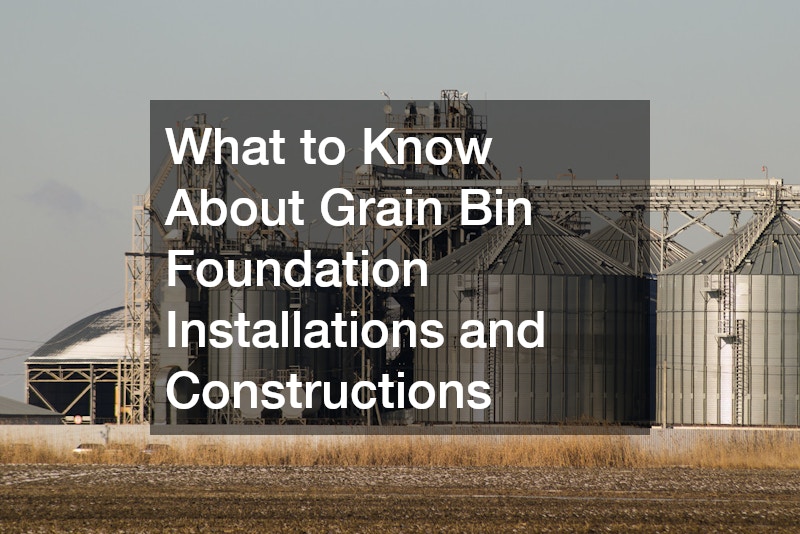What to Know About Ground Bin Foundation Installations and Constructions

Learn about the crucial elements and considerations in installing and constructing a grain bin foundation, vital for ensuring the stability and longevity of grain storage facilities. A comprehensive understanding of these aspects can lead to more efficient storage solutions and protect your investment in agricultural infrastructure for years to come.
What Are the Basics of Grain Bin Foundation Installations?
Types of Foundations
Explore different foundation types such as poured concrete, precast concrete pads, and gravel bases. Each type has its unique advantages, with poured concrete providing rigidity and strength while precast options offer ease of installation and versatility.
Gravel bases, often used for smaller bins, are cost-effective and provide necessary drainage. The choice of foundation should align with the specific grain bin size and the environmental conditions of the site.
Proper selection ensures the structure can support the weight of the grain and withstand adverse weather conditions. By considering these factors, you can achieve a robust foundation capable of long-term reliability.
Key Installation Steps
Understand the step-by-step process required to install a grain bin foundation correctly. It begins with site preparation, which involves leveling the ground and confirming soil stability through tests.
The next step is formwork construction, ensuring the correct shape and size before pouring concrete. Accurate measurement and effective formwork setup can prevent foundation distortions and weaknesses.
Finishing includes curing the concrete properly to achieve the desired strength and making necessary modifications for bin placement. Adherence to these steps enhances the durability and effectiveness of the foundation over time.
How to Choose the Right Location for Grain Bins?
Soil Testing and Site Preparation
Learn about the importance of conducting soil tests and preparing the site for construction. These measures help identify soil compatibility with heavy structures, ensuring a safe and lasting foundation.
Soil testing can reveal issues like moisture content and compaction level, which are critical for foundation support. Proper analysis and adjustments mitigate potential future challenges related to soil movement and water damage.
Site preparation considers factors such as grading for drainage and access for construction equipment. This groundwork lays the foundation for a successful project outcome by minimizing later-stage obstacles and delays.
Factors Influencing Location Choice
Examine the critical factors such as accessibility, drainage, and future expansion needs. Important considerations include proximity to roads for ease of transport and the potential for connecting supporting infrastructure.
Drainage is essential to prevent water accumulation, which can undermine the foundation and compromise the grain’s quality. Considering future growth can prevent additional costs, allowing for seamless process expansion as needs grow.
Surveying the landscape for its topographic and environmental impacts facilitates smarter placement decisions. This holistic view ensures strategic siting, catering to both current and future operational requirements.
What Materials Are Needed for Constructing a Grain Bin Foundation?
Essential Construction Materials
Identify the primary materials needed, like concrete, rebar, and moisture barriers. Concrete provides structural integrity, while rebar adds tensile strength and supports weight distribution.
Moisture barriers are critical in protecting against water ingress, maintaining foundation durability. Ensuring the use of quality materials contributes to structural stability and longevity, minimizing repair needs.
Additional materials might include vapor barriers and insulation for thermal efficiency. By using appropriate resources, you enhance construction quality and support long-term operational benefits.
Material Quality and Sourcing Tips
Gain insights into selecting quality materials and finding reliable suppliers. High-grade materials prevent foundation failure and reduce moisture infiltration risks.
Working with established suppliers ensures consistent material quality and support throughout the construction process. Supplier reputation and product certifications act as indicators of promised performance and reliability.
Negotiating favorable terms with providers can yield cost-effective solutions while securing premium materials. Establishing a trustworthy, ongoing partnership is crucial for efficient material management.
What Challenges Are Often Encountered in Grain Bin Foundation Construction?
Common Construction Issues
Discuss frequent problems such as soil compaction and moisture infiltration. Soil compaction can lead to uneven settling, impacting stability and necessitating advanced corrective measures.
Moisture infiltration can undermine the foundation, reducing its support and leading to structural complications. Early detection and resolution are critical in avoiding substantial remediation costs.
Additional issues can arise with improper drainage management, further exacerbating water exposure. A proactive approach identifies potential sources of difficulty, ensuring timely intervention and problem-solving strategies.
Strategies to Overcome Challenges
Explore effective techniques to address and mitigate common construction challenges. Compaction issues can be managed by selecting appropriate soil types and incorporating reinforcement where necessary.
Effective moisture control involves implementing drainage systems and using barriers to direct water away from the foundation. These measures help maintain a stable environment conducive to grain storage safety.
Proactive risk management includes continuous monitoring and quick response capabilities. Investing in these efforts ensures resilient construction outcomes, protecting the overall value and integrity of storage investments.
What Are the Best Practices for Maintaining Grain Bin Foundations?
Regular Inspection and Maintenance Tips
Learn the importance of regular inspections and routine maintenance for foundation longevity. Inspections reveal early signs of wear, allowing for prompt and effective remedy implementation.
Maintenance activities may include adjusting moisture barriers and addressing minor cracks before they develop into more significant concerns. Establishing scheduled checks maintains the foundation’s robust condition over the long term.
Utilizing technology such as moisture sensors aids in constant monitoring efforts. This proactive stance helps in predicting foundation behaviors and optimizing maintenance strategies.
Repair and Reinforcement Methods
Understand repair strategies and reinforcement methods for existing foundations. Techniques like crack sealing and underpinning can bolster structural support where vulnerabilities appear.
Reinforcement often includes the introduction of additional rebar or the application of concrete overlays. These enhancements distribute loads more evenly, prolonging foundation life amidst evolving environmental conditions.
Regular assessment of these methods ensures they align with industry standards and remain effective. Implementing appropriate measures protects investments and keeps the storage infrastructure in optimal working order.







